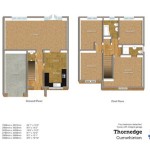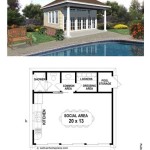Unveiling the Blueprint: Essential Aspects of a House Plan Drawing
When embarking on the journey of building your dream home, the blueprint serves as an invaluable roadmap, guiding every step of the construction process. Understanding its key elements ensures the seamless transformation of architectural designs into a tangible reality.
Floor Plans: Laying the Foundation
Floor plans are the backbone of a house plan drawing, meticulously detailing the arrangement and dimensions of each level of your home. They provide a comprehensive overview of the layout, including the placement of rooms, windows, doors, and staircases.
Elevations: Capturing the Facade
Elevations depict the exterior appearance of your home from various angles, showcasing the architectural style, roof pitch, and window and door configurations. They enable you to visualize the overall aesthetic appeal of your property.
Sections: A Cross-sectional View
Sections offer a vertical perspective of your house, revealing the structural details and relationships between different components. They illustrate the height of rooms, ceiling configurations, and the flow of spaces.
Roof Plan: Shaping the Shelter
The roof plan delineates the shape, slope, and drainage system of your roof. It specifies the type of roofing materials to be used, providing clarity on the structural integrity and aesthetic appeal of your home's protective shelter.
Electrical Plan: Powering Your Home
The electrical plan meticulously outlines the electrical infrastructure of your house. It indicates the location of outlets, switches, lighting fixtures, and electrical panels, ensuring the efficient and safe distribution of electricity throughout your living spaces.
Plumbing Plan: Ensuring Water Flow
The plumbing plan serves as a blueprint for the water and drainage systems of your home. It details the placement of pipes, fixtures, and appliances, guaranteeing the smooth flow of water, efficient flushing, and proper waste disposal.
HVAC Plan: Controlling the Climate
The HVAC plan outlines the heating, ventilation, and air conditioning systems within your home. It specifies the location of units, ducts, vents, and thermostats, ensuring optimal indoor comfort and air quality.
Understanding Scales and Dimensions
House plan drawings adhere to specific scales, which determine the ratio of the drawing to the actual size of the structure. Understanding these scales is crucial for accurately interpreting the dimensions and proportions of your home.
Working with Professionals
Collaborating with licensed architects and engineers is essential for creating precise and compliant house plan drawings. Their expertise ensures adherence to building codes, structural integrity, and aesthetic coherence.
Conclusion
A comprehensive house plan drawing serves as a vital tool in the construction of your home, providing a clear roadmap for every aspect of the process. By comprehending the essential elements outlined in this article, you gain a deeper understanding of your home's design and layout, empowering you to make informed decisions and ensure the successful realization of your dream abode.

Floor Plan Creator And Designer Free Easy App

Floor Plan House Sketch Stock Vector Ilration Of Building 52483697 Plans

Floor Plans Types Symbols Examples

Example Of House Plan Drawing Scientific Diagram

Draw Floor Plans With The Roomsketcher App

Easy Home Building Floor Plan Cad Pro

House Plan Drawing Everything You Need To Know

Draw Floor Plans With The Roomsketcher App

Home Floor Plans House Plan Drawings

How To Draw A Floor Plan By Hand Step Guide








